#image bank mediterranean
Text

#mine#my photography#my photo#firstpersonnarrator#simon x billy#simon is simon#bay of naples#baie di Napoli#Mediterranean sea#tyrrhenian sea#tyrrhenian#medi/tyrrhenian sea#robert sheehan#simon lewis#location naples#location water#image bank sunset#image bank water#image bank mediterranean#location mediterranean#location Medi/tyrrhenian#location sorrento#location boat#image bank sunset on water#location sea
9 notes
·
View notes
Text
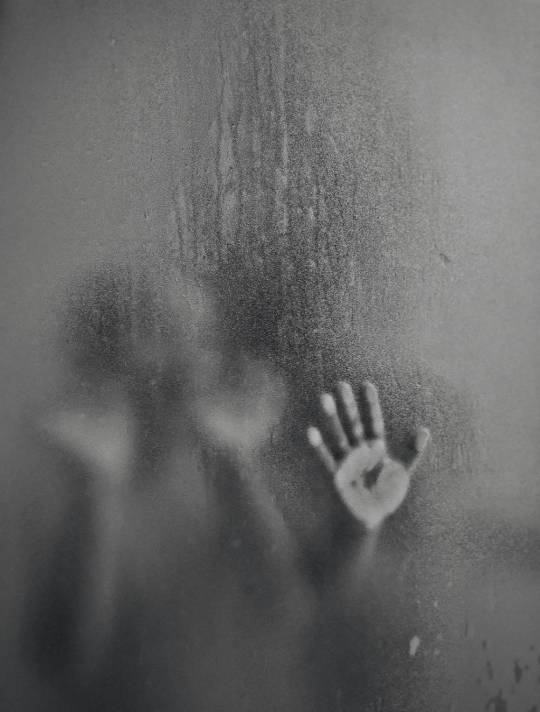
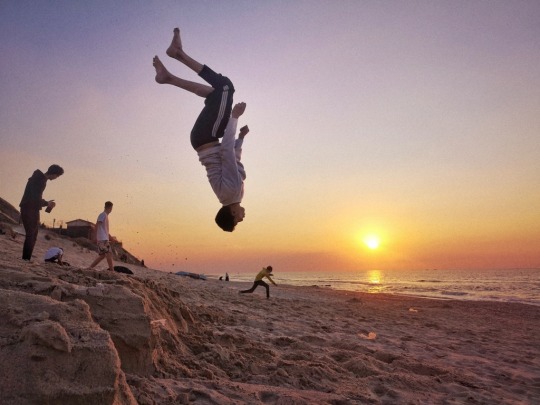

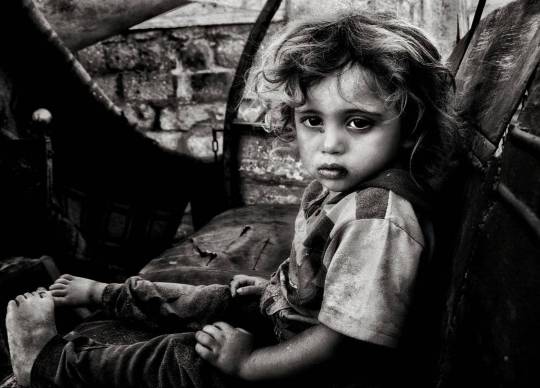
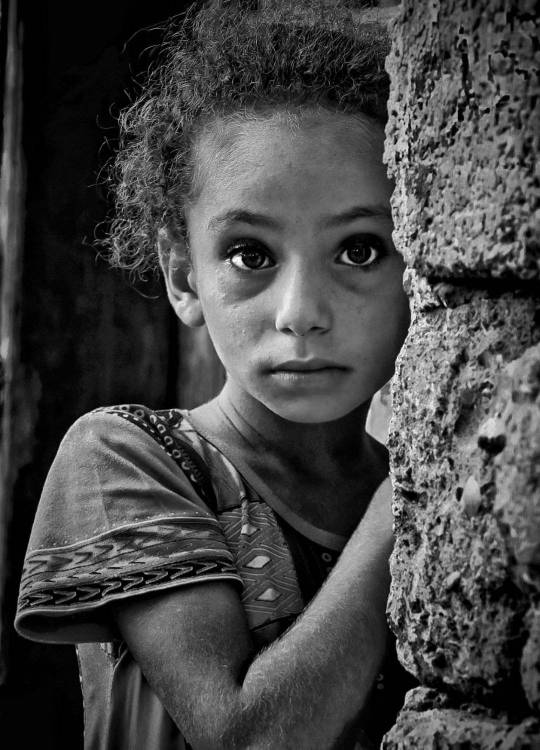
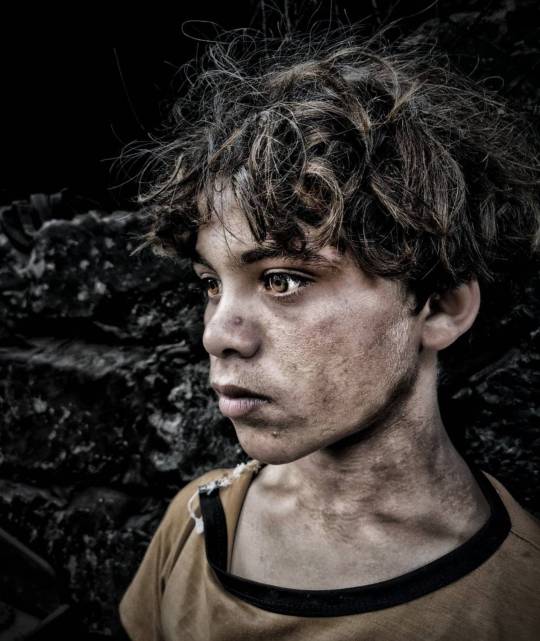
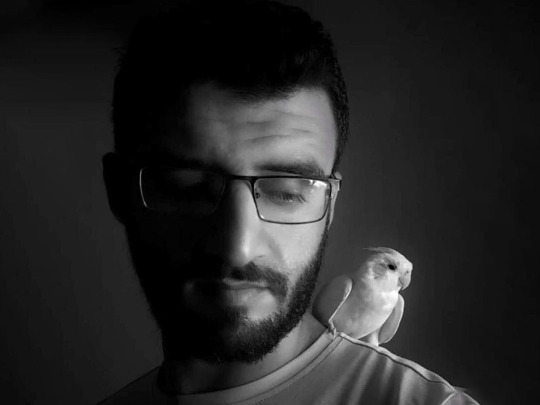
Majd Fadl Arandas (1994–2023)
The Palestinian artist’s images document and celebrate life in the Gaza Strip, excavating pockets of optimism and resistance amidst loss and destruction.
Majd Arandas was murdered by an Israeli airstrike near his home in the Deir al-Balah Governorate in the central Gaza Strip on Wednesday, November 1. Remembered by friends and colleagues as a "kind and gentle soul" .
The 29-year-old self-taught artist loved to take photographs of the Mediterranean sea and Gaza. The importance of the artist’s work lies in the urgency of documenting and celebrating Palestinian life, excavating pockets of optimism and resistance amidst loss and destruction.
His love for Gaza shone through in his photographs, seen in his steadfast portrayals of joy and beauty.
Whimsical compositions by the sea depict young boys jumping and playing. In a series of works focused on his grandmother, a survivor of the 1948 Nakba who was displaced from her native village of Isdud, Arandas portrays her as a symbol of strength and perseverance in Gaza, zooming in on her weathered hands harvesting olives against deep fertile earth.
Traces of personal and cultural histories can be seen in the crisp light of ripe olives and the details of intricate embroidery adorning her hanging dress.
Arandas had a network of colleagues and friends around the world whom he never met due to the restrictions of living under siege. Photojournalist Rita Kabalan explained that the conditions of the Israeli blockade prevented him from many opportunities, and that he was killed “just as people were starting to take note of his work.”
As Israel continues its deadly attacks on Gaza the West Bank and Cisjordania, Arandas contributed prints to a fundraising sale organized by the Dubai-based gallery Gulf Photo Plus.
The artist’s father, Fadl Arandas, recounted the circumstances of his son’s killing, explaining that Arandas ran to the top of the building when the bombing occurred to identify its source and then quickly left to help his afflicted neighbors. It was only a few minutes until they heard a second explosion of an Israeli missile that struck Arandas with shrapnel in the head and claimed his life.
“He dreamed of traveling to see the world,” said his brother Mou’ayad Arandas. “He was killed doing what he loved to do: helping people.”
#human rights#art#humanity#equal rights#freedom#photography#peace#israel#free gaza#gaza strip#gazaunderattack#save gaza#palestinians#free palestine#majd aranda#murder#murder drones#nakba 2023#nakba#genocide#settler colonialism#war crimes#colonialism#crimes against humanity
11 notes
·
View notes
Text


Storm Aftermath in Derna, Libya
Heavy rain from a cyclone in the Mediterranean inundated cities along the northeastern coast of Libya in early September 2023, causing thousands of deaths. The port city of Derna (Darnah), home to about 90,000 people, was one of the worst hit by the storm and suffered extensive flooding and damage.
On September 10 and 11, over 100 millimeters (4 inches) of rain fell on Derna. The city lies at the end of a long, narrow valley, called a wadi, which is dry except during the rainy season. Floods triggered two dams along the wadi to collapse. The failure of the second dam, located just one kilometer inland of Derna, unleashed 3- to 7-meter-high floodwater that tore through the city. According to news reports, the flash floods destroyed roads and swept entire neighborhoods out to sea.
The images above show the city before and after the storm. The image on the right, acquired by the Operational Land Imager-2 (OLI-2) on Landsat 9 on September 18, shows eroded banks of Wadi Derna near where it meets the Mediterranean. Water just off the coast appears muddier than in the image on the left, which shows the same area on August 25 and was acquired by Landsat 8.
Preliminary estimates by the United Nations Satellite Center (UNOSAT) indicate that 3,100 buildings in Derna were damaged by rushing water. According to the UN International Organization for Migration (IOM), about 40,000 people in the country were displaced by the storm, and 30,000 of those were displaced from Derna.
Tropical-like cyclones in the Mediterranean, or “medicanes,” develop only once or twice a year, according to NOAA, and typically form in autumn. According to meteorologists at Yale Climate Connections, this storm was the deadliest in Africa’s recorded history. A recent assessment by scientists at World Weather Attribution estimated that precipitation received by the region was a one-in-300 to one-in-600-year event.
NASA Earth Observatory images by Lauren Dauphin, using Landsat data from the U.S. Geological Survey. Story by Emily Cassidy.
9 notes
·
View notes
Text
Symbols of Forever Palestine 🇵🇸!
What the Keffiyeh, the Olive Branch, Handala and the Watermelon Represents in Terms of Palestinian Odentity and Resistance.
— By Mohammed Haddad, Konstantinos Antonopoulos and Marium Ali | Published: 20 November 2023
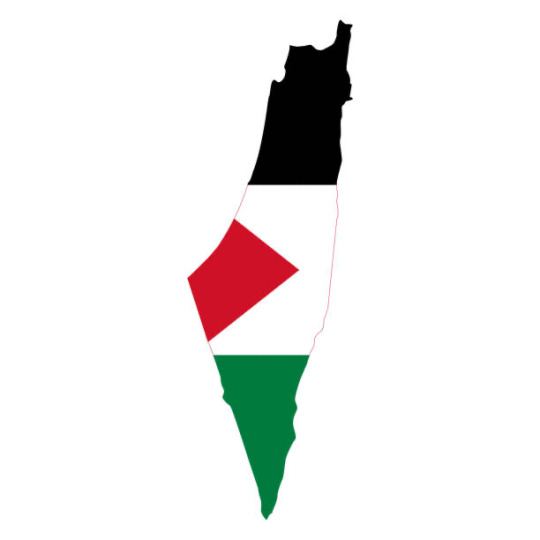
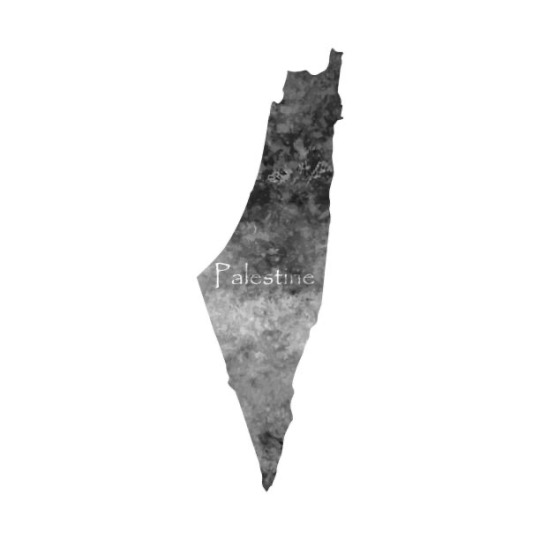
In hundreds of cities worldwide, demonstrators have rallied in solidarity with Palestinians in Gaza, donning the emblematic black-and-white Palestinian headdress known as the keffiyeh.
Among them, demonstrators carry large keys, a cartoon portraying a child with their back turned, and even an image of a Watermelon 🍉, each representing a different way of supporting the Palestinian cause.
In this infographic series, Al Jazeera showcases eight symbols that represent Palestinian identity and resistance to Israeli occupation.
A keffiyeh, also spelled kuffiya, is a square-shaped cotton headdress with a distinctive chequered pattern worn in many parts of the Arab world.
The black-and-white variant, worn by Palestinian men and women, has come to symbolise the Palestinian struggle for self-determination, justice and freedom.
The Olive-Leaves Pattern represents perseverance, strength and resilience.
The Gishnet Pattern represents Palestinian fishers and the people's connection to the Mediterranean.
The Bold Pattern represents trade routes with neighbouring merchants of Palestine.
The garment, originally used to protect individuals across the Middle East against the sun, gained popularity during the Arab Revolt against British colonial rule in the 1930s.
The keffiyeh was also the personal trademark of Yasser Arafat, the late Palestinian leader. He would wear it folded in a triangle shape and draped over his shoulders, covering his head.
Today, the keffiyeh has been adopted globally by individuals, activists and organisations to support the Palestinian cause.
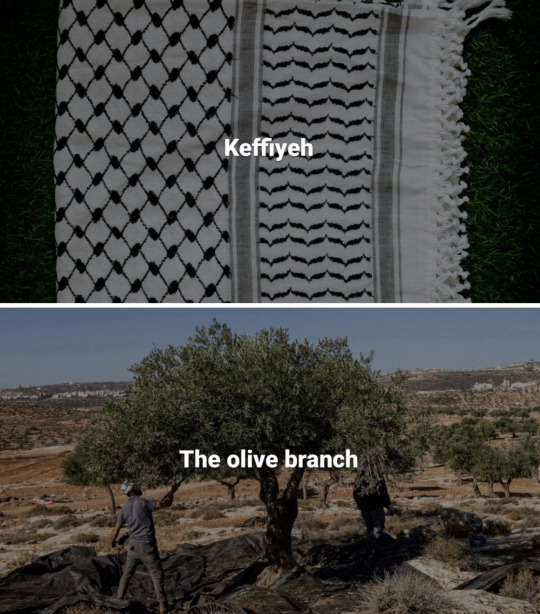

The olive tree has deep historical and cultural roots in Palestine, and its branches have been associated with peace and prosperity for centuries.
The hardy trees can handle drought, subzero temperatures, frost and even fire. They are symbolic of Palestinian resilience against Israeli occupation and their connection to the land.
Olive cultivation plays a crucial role in the Palestinian economy through olive oil, table olives and soap production.
About 80,000 to 100,000 Palestinian families rely on the olive harvest for their income, which takes place every year between October and November. Traditionally, the harvest season is a time of festivities and joy, but tight Israeli restrictions and settler attacks overshadow it.
According to the UN, more than 5,000 olive trees belonging to Palestinians in the West Bank were damaged in the first five months of 2023.
In 1974, Yasser Arafat, then the leader of the Palestine Liberation Organization (PLO), famously said in a speech addressed to the United Nations General Assembly:
“Today I come bearing an olive branch in one hand and the freedom fighter's gun in the other. Do not let the olive branch fall from my hand. I repeat, do not let the olive branch fall from my hand”.
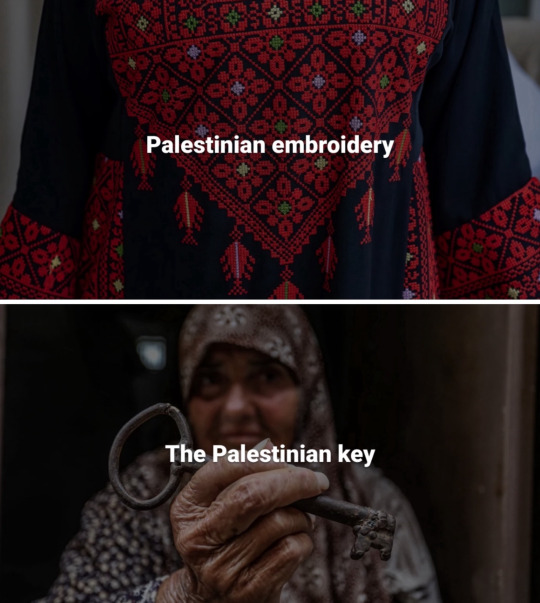

In 1948, Zionist military forces expelled at least 750,000 Palestinians from their homes and lands in what became known as the Nakba (“catastrophe” in Arabic). Those people took their keys with them, sure they would return.
Many Palestinians still hold onto the keys to their original homes as a symbol of their hope and determination to return one day. These keys have been passed down several generations and are kept as a symbol of Palestinians’ right to return - a principle enshrined in international law that grants individuals the right go back to their homes of origin.
During Israel's latest offensive in Gaza, at least 1.5 million Palestinians have been driven out of their homes, double the number of those displaced during Nakba in 1948. For Palestinians, Nakba is not a discrete historical event. It is an ongoing process of displacement that has never stopped.
The outline map of historic Palestine represents the geographical area associated with the region before the establishment of the state of Israel in 1948. The map serves as a visual representation of Palestinian claims to their land and self-determination.
In 1948, Zionist military forces expelled at least 750,000 Palestinians from their homes and captured 78 percent of historic Palestine. The remaining 22 percent was divided into what are now the occupied West Bank and the besieged Gaza Strip.
There are 7 million registered Palestinian refugees living in camps located throughout Palestine and neighbouring countries. The plight of Palestinian refugees is the longest unresolved refugee problem in the world.
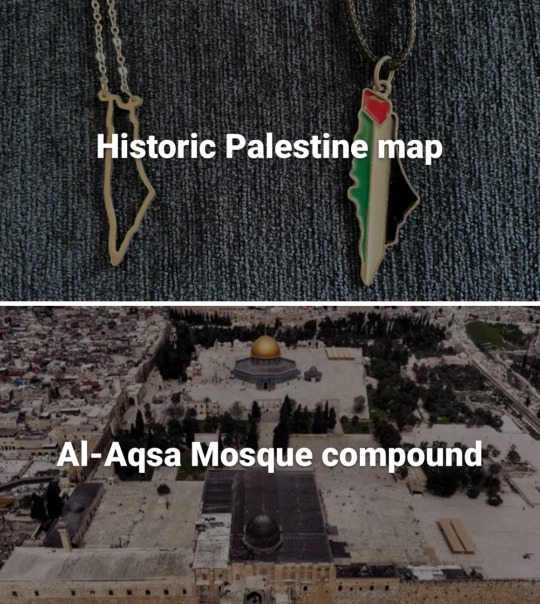
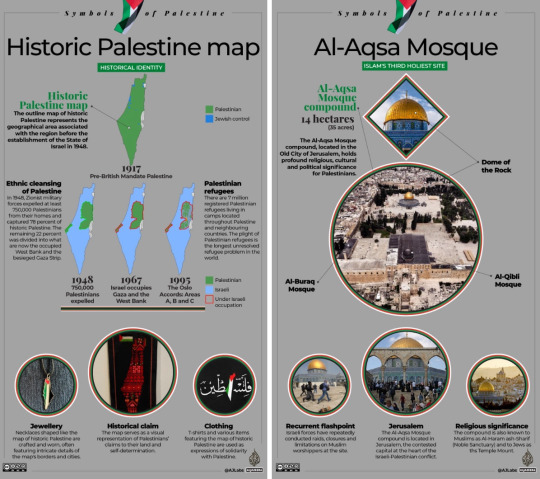
Necklaces shaped like the Palestinian map are crafted and worn, often featuring intricate details of the map's borders and cities. T-shirts and various items featuring the map of historic Palestine are used as expressions of solidarity with Palestine.
The Al-Aqsa Mosque compound is located in Jerusalem, the contested capital at the heart of the Israeli-Palestinian conflict.
The 14-hectares (35-acres) compound contains the al-Qibli Mosque (grey dome) and the Dome of the Rock (golden dome) and holds profound religious, cultural and political significance for Palestinians.
Muslims believe that it is from Al-Aqsa where the Prophet Muhammad ascended to heaven during the Night Journey (Isra' and Mi'raj). As such, it's considered one of the holiest sites in Islam after the Kaaba in Mecca and the Prophet's Mosque in Medina.
The compound is known to Muslims as al-Haram ash-Sharif and to Jews as Temple Mount.
The site is a recurrent flashpoint, with Israeli forces repeatedly conducting raids, closures and limitations on Muslim worshippers at the site.
Handala is a cartoon character created by Palestinian cartoonist Naji al-Ali that reflects his own childhood refugee experience and the ongoing plight of Palestinians displaced by the Nakba.
The first version of the cartoon appeared in a Kuwaiti newspaper in 1969 and was drawn facing the viewer. However, in 1973 following the October War, al-Ali started drawing Handala with his back turned to reflect how the world had itself turned its back on the Palestinians.
Handala is barefoot and wears ragged clothes like the refugee camp children al-Ali remembers when he was forced to leave his village as a 10-year-old boy.
Handala is named after the “handhal”, a bitter fruit that grows in the dry areas of Palestine. It grows back when cut and has deep roots.
In 1987, Naji al-Ali was assassinated in London. No one has been charged with his murder.

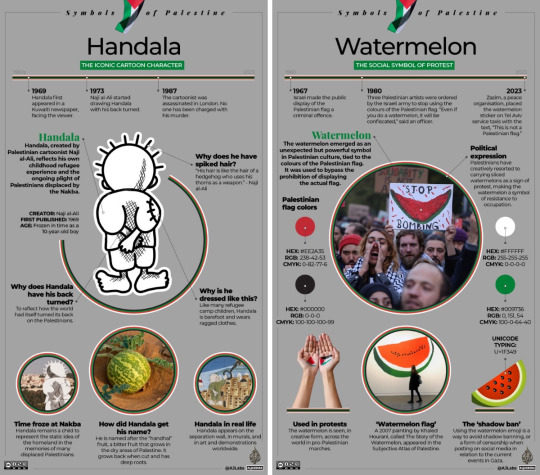
The watermelon is perhaps the most iconic fruit to represent Palestine. Grown from Jenin to Gaza, the fruit shares the same colours as the Palestinian flag – red, green, white and black – so it is used to protest against Israel’s suppression of Palestinian flags and identity.
Following the 1967 war, when Israel seized control of the West Bank and Gaza Strip and annexed East Jerusalem, the government banned the Palestinian flag in the occupied territory.
Although the flag has not always been banned by law, the watermelon caught on as a symbol of resistance. It appears in art, shirts, graffiti, posters and the ubiquitous watermelon emoji on social media.
In January 2023, the police were instructed to confiscate Palestinian flags from public places. This was followed in June by a bill to ban the flag in state-funded institutions.
In response, Zazim, a grassroots Arab-Israeli peace organisation, placed the Palestinian flag – in watermelon form – on about a dozen Tel Aviv service taxis.
In the current conflict, people have been using the watermelon emoji as a way to avoid getting “shadowbanned” on social media when posting about current events in Gaza.
#Al-Jazeera English#Forever Palestine 🇵🇸#Symbol of Palestine 🇵🇸#Keffiyeh#The Olive 🫒 Branch#Palestinian Embroidery 🪡 🧵#The Palestinian Key 🔑#Historic Palestine 🇵🇸 Map 🗺️#Al-Aqsa Mosque 🕌 Compound#Handala#Watermelon 🍉
2 notes
·
View notes
Text
Naples (2): Neapolis or Nablus?
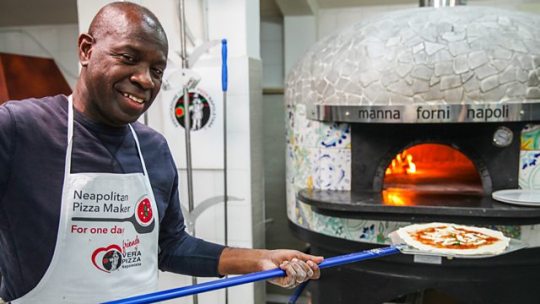
To prepare for our trip we watched Clive Myrie's good-humoured BBC series on Italy.
The episode on Naples, which aired just before we travelled, portrayed the city as a glorious melting pot brimming with history and conviviality, the home of pizza and the beating heart of the multicultural south.
Workshops in picturesque alleyways were "fast becoming one of the city's most exciting creative hubs", Myrie told us.
I'd also read Gomorrah by the investigative journalist Roberto Saviano, which depicts Naples and its region as a crime-ridden hellhole.
I kept those contrasting images vivid in my mind by calling the first Neapolis and the second Nablus (Naples and the impoverished West Bank city, both ancient Greek settlements, share a common etymology.)
Outside the airport terminal, we followed signs for the buses. I wasn't completely sold on that mode of transport: the Alibus website showed pictures of long lines of backpackers waiting to board under a hot sun, which did not bode well for the frequency of the service. On the other hand, the fare was cheap (€5) and as the night had fallen we were at little risk from sunstroke.
On our way to the bus stop, a man offered to drive us to the city centre, along with a few fellow tourists, for €5 each. Being accosted and directed towards a collective taxi was more evocative of Nablus than Neapolis, but we decided to take a chance.
The minivan was comfortable and delivered us to Piazza Garibaldi in 20 minutes. This was Neapolis after all. The driver even pointed the way towards our hotel.
Like most central squares in European cities, the Piazza Garibaldi features vast open spaces, far-reaching transport links and the statue of a national hero. But while similar urban foci across the Mediterranean world are usually alive with crowds in the evening, the piazza offered nothing but empty gloom.
The main road along the Centro Storico was not much more animated. A fast-food joint was open. A few shadows shuffled past. After 300m we turned into ramshackle lanes strewn with refuse: definitely Nablus.
I wondered if we might have got lost. How could such a slum attract tourists? But Google Maps does not lie: we found our hotel tucked away behind a metal door.
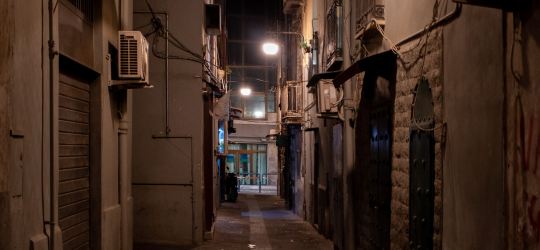
"Is there a place where we can eat around here?"
My tentative query was met by a confident response. "Pizzeria del Popolo: 300m away, just across Piazza Mercato," the young woman at the reception said.
The piazza in question would make a perfect location for a brutalist dystopia. Lined on one side by a housing block that shows every sign of having been built with what Roberto Saviano calls "Camorra cement", it is dominated by an installation shaped like a giant dog turd. Not a soul was stirring.
We found our restaurant, as discreetly positioned as our hotel, at the bottom of the housing block. Once inside, the atmosphere changed.
Maybe that's what happy families do in Naples in the evening: they go to the pizzeria instead of hanging out in squares. A 31st birthday was being celebrated at one table. It was vibrant and proper – none of the boozy ruckus such events occasion in Britain.
My only quibble was the lack of wine: real Neapolitans, it seems, wash down their food with beer. But they sure can do pizza here: unctuous dough and fresh ingredients for €8 - a ridiculously small price to pay for a taste of Neapolis in the middle of Nablus.
Previous entry on Naples:
. Ryanair
2 notes
·
View notes
Text
On this day in Wikipedia: Thursday, 4th April
Welcome, velkomin, vítejte, bienvenido 🤗
What does @Wikipedia say about 4th April through the years 🏛️📜🗓️?

4th April 2023 🗓️ : Event - Finland
Finland becomes a member of NATO after Turkey accepts its membership request.
"Finland, officially the Republic of Finland, is a Nordic country in Northern Europe. It borders Sweden to the northwest, Norway to the north, and Russia to the east, with the Gulf of Bothnia to the west and the Gulf of Finland to the south, opposite Estonia. Finland covers an area of 338,145 square..."
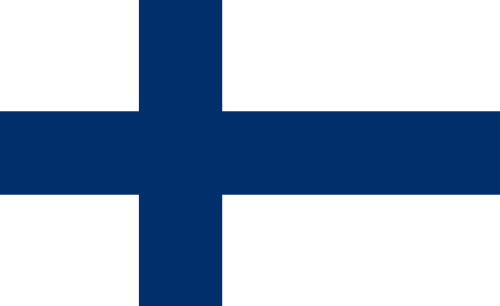
Image by SVG Vectorization: Sebastian Koppehel
4th April 2017 🗓️ : Event - Khan Shaykhun chemical attack
Syria conducts an air strike on Khan Shaykhun using chemical weapons, killing 89 civilians.
"The Khan Shaykhun chemical attack took place on 4 April 2017 on the town of Khan Shaykhun in the Idlib Governorate of Syria. The town was reported to have been struck by an airstrike by government forces followed by massive civilian chemical poisoning. The release of a toxic gas, which included..."
4th April 2014 🗓️ : Death - Curtis Bill Pepper
Curtis Bill Pepper, American journalist and author (b. 1917)
"Curtis Bill Pepper (August 30, 1917 – April 4, 2014) was an American journalist and author, who published seven books. He was Newsweek's Mediterranean bureau chief in Rome from the mid-1950s to mid-1960s. He also worked for Edward R. Murrow at the Rome bureau of CBS, and covered the Vatican for..."
4th April 1973 🗓️ : Event - World Trade Center (1973–2001)
A year after the completion of the second of the complex's twin towers, the World Trade Center in New York City was officially dedicated.
"The original World Trade Center (WTC) was a large complex of seven buildings in the Financial District of Lower Manhattan in New York City. It opened on April 4, 1973, and was destroyed during the September 11 attacks in 2001. At the time of their completion, the Twin Towers—the original 1 World..."

Image by Jeffmock
4th April 1924 🗓️ : Birth - Bob Christie (racing driver)
Bob Christie, American race car driver (d. 2009)
"Bob Christie (April 4, 1924 – June 1, 2009) was an American racecar driver. Christie raced in the USAC Championship Car series in the 1956-1963 seasons, with 15 career starts, including every Indianapolis 500 race in that span. He finished in the top ten 5 times, with his best finish in 3rd..."
4th April 1821 🗓️ : Birth - Linus Yale Jr.
Linus Yale Jr., American engineer and businessman (d. 1868)
"Linus Yale Jr. (April 4, 1821 – December 25, 1868) was an American mechanical engineer, manufacturer, and co-founder with millionaire Henry R. Towne of the Yale Lock Company, which became the premier manufacturer of locks in the United States. He was the country's leading expert on bank locks and..."
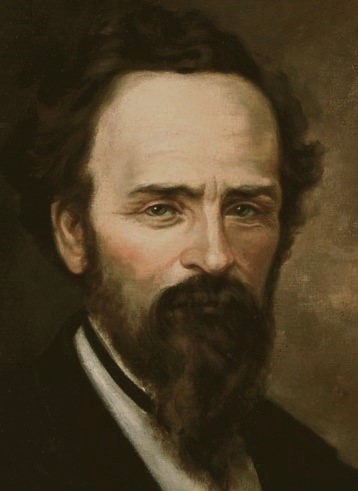
Image by Unknown, before 1868
4th April 🗓️ : Holiday - Christian feast day: Tigernach of Clones
"Tigernach mac Coirpri (d. 549) was an early Irish saint, patron saint of Clones (County Monaghan) in the province of Ulster. ..."
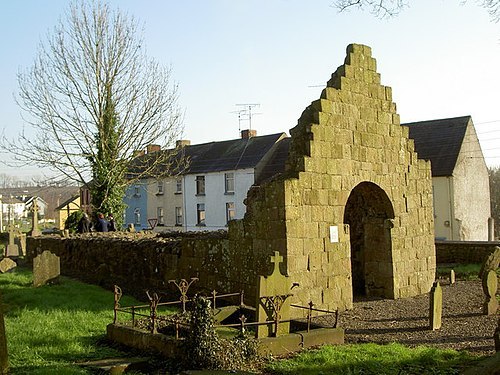
Image licensed under CC BY-SA 2.0? by David Quinn
1 note
·
View note
Text
@geekandmisandry I couldn't reblog your post so I'm replying to you here. Maybe OP blocked me, maybe you blocked me, maybe Tumblr's just being a buggy mess, I don't know.
Firstly, I am not saying that anyone I disagree with is in a bubble, but I think it is common for people, regardless of freedom of press, to be in political bubbles. Perhaps you are using the term more narrowly than I am.
Main point: This completely conflicts with my experience of how people think about politics. I live in the UK, where people don't like refugees much, to put it mildly (I am given to understand Australia is the same). For years, the right-wing press has been demonising people crossing the Mediterranean, and 'just let them die' was a mainstream opinion. People knew that thousands had died making the crossing, largely due to policies they supported, and that corpses were washing up on beaches in Greece. Then this picture was taken, of Alan Kurdi, dead, and was everywhere, and a lot of the same people were shocked and horrified.


There was, it seemed to me, a noticeable ramping down of anti-refugee rhetoric for months after, and politicians would be far more mild about refugees whenever that picture was put up next to them.
I think othered people - like refugees, like Palestinians, just don't get thought about as people very much - people of course know they are human, but don't bother to consider their interests. But when you look someone in the face you can't help but be confronted with that. Alan Kurdi looks just like your nephew. I think that confronting people, viscerally, with what they already intellectually know is going on can be a very powerful tool to change people's minds.
I don't want this to be about OP's proposal. I am talking about the general case, and am not advocating showing people gruesome images against their will.
And that example is the weakest possible case: pictures can do more than that by being undeniable evidence in the face of apologetic narratives. People who say the Oct 7 attack was justified tend to go quiet when shown pictures of the bodies in the streets in its wake. And people who say the IDF is the most moral army in the world will backtrack when shown the Flour Massacre. And I think this reflects a genuine shift in people's views.
I think that 'living in a bubble' is a spectrum, and most people are not completely unaware of opposing perspectives, but most people lack much understanding of opposing perspectives: leftists can't explain why perfect markets are efficient and rightists can't explain why intersectionality matters. People generally have enough awareness to think that they understand their opponents, but not enough awareness that any of their accepted narratives are challenged. And I think that's pretty bubbly.
And I don't think it's true that people are constantly exposed to media that disagrees with them, at least not on a lot of issues. The UK media is completely fucked (in large part by one of your citizens, you know) and the most left-wing the mainstream media gets is the Guardian. This means you have to go out of your way to even find voices in favour of publicly run banks. The range of perspectives on offer is pretty narrow, and worse, media have a tendency to fall behind the government line on military operations, like the invasion of Iraq, like the airstrikes in Yemen. This means people might know the basic facts, but not understand why people draw different conclusions from those facts than the official narrative, and are likely to be missing out on more obscure facts that are pivotal to those alternative narratives.
And I think this is similar in Australia, and in Israel. And just, as I said, I've spoken to Israelis who were pretty clueless. Not because they knew nothing, but because they knew little beyond the official narrative.
In conclusion, challenging OP on the grounds that showing people things they already know about/basic information is always an ineffective way of changing people's minds is mistaken.
0 notes
Link
0 notes
Text
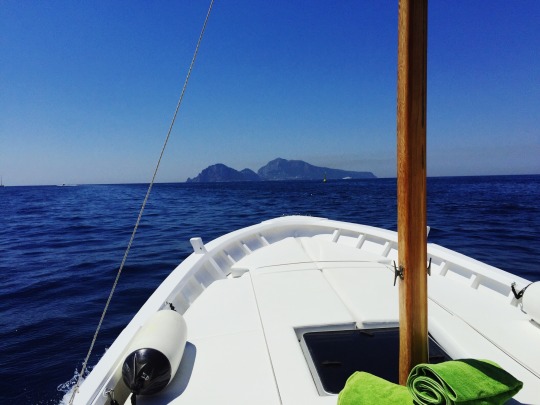
Not yet, but soon…
#location sea#location capri#location water taxi#location water#location image bank#image bank: location#a mortal instruments au#robert sheehan character fic#simon x billy#mediterranean#amalfi coast#tyrrhenian sea#capri#me and mrs jones#bbc me and mrs jones#the mortal instruments#the mortal instruments fanfic#mortal instruments au#a me and mrs jones au#robert sheehan character fanfic#boat to capri
1 note
·
View note
Text
Ezekiel 28:12-13 - The quest for fulfilment.
In the middle of the sea, the world and the universe lies a place that only those who believe can access. In a noetic network, the information that is in the network and the information that is shared by the minds perceiving the network are seen as a collective and continuous conscious- ness.1 Beyond doubt you cannot assume that it is the highest possible intelligence; for to do so you would have to see that a greater intelligence than that of which you perceive any evidence in the world is inconceivable, which means attributing omniscience to yourself. In the same way you infer from the greatness of the world a very great might on the part of its author.2 The simpleton man, who was only one Scheherazade among so many others, was driven by his quest of desire of being more, following a Faustian matter. The harpies rage against these sea migrants and their infortune, but this quest seems to be the only one that escapes the human condition. They are desperately seeking for the lands of Ceres. The real difference between men and God, if He exists, must be that He created the world of things and the diversity of humankind by omnipotence and omniscience, whereas we, for the moment, create children whose bodies and spirits are unpredictable, in an unpredictable world.3
Revelation 21:3 - The Pact with God.
As the migrants of hope landed on the shores of the socalled land of fulfilment, Gods showed them how to transform these arching harpies into birds and the tumult of the waves that preceded them into the melodies of Te Deum. That which cannot contain the happy life cannot contain that which produces the happy life; and the happy life is produced by Goods alone.4
The mist spread all around them like the omnipotent tumult of thousands of voices; they learned to accept their myopia as well as to cure it. Life, that is, expressivity, is carried into the absolute.5 Thus the oracles join the community of Gods that populates the Mediterranean Olympus.
Genesis 11:6 – The Collective.
At the symposium banquet it is allegories that drink: comedy, tragedy, medicine. They speak allegorically. This never becomes clear until one has attended an invited banquet where each chair represents an institution, where each guest is there to represent politics, science, banking, the media or public administration the powers of the moment.The dinner mimics that of the gods the individuals present believing that the mere loss of their individuation makes them gods. The hostess could have invited robots who would have said what they were programmed to say, at the push of a button: what an administrator or journalist says can never surprise us, they are celebrating their power. For a long time I believed that the loss of individuation was due to the wine circulating around the room and becoming a collective subject by taking on the individuality of each person as it did the rounds; and that the wine became us, objectively conveying the sum of the I’s entrusted to it by each subject, lost, in an ecstatic trance; but the loss occurs differently, for each person enters like a statue. Allegory, a block of marble carved into a representation, speaks.6
Revelation 21:2 – City of God.
Thus, even though the use of space for this specific action by unauthorized individuals might have been illegal, it became acceptable and unnoticeable because it was disguised as a dominant type of action that was legitimate in the collective consciousness.7 This island, an image of the Olympus of yesteryear, promised the cerbertus, who softened their faces by becoming Ushnishavijaya, the plenitude. A garden of oppressive freedom where the oracle can absolve himself of his condition as an earthly thinker.
Leviticus 19:18 - Beyond the Plentiness.
Here is the shadow and the light, suffering and omniscience. The third person of the Trinity, the Holy Spirit, takes the form of a bird, a dove, sometimes the appearance of a tongue of fire.8 Divine omniscience does not extend to itself.9 A journey to discover other faces through the iris of Eden, those of others and our own. To discover the truth.10 And there is plenty of it left even for posterity to discover.11 Love, humanity and the dissolution of ignorance opened the way to divine consciousness. At the center of the star is hidden the third place, formerly called a soul, experienced by passing through a channel that is difficult to cross.12 The heart; the blood; the vital spirit.13 Above the tumultuous clouds, they marvelled at the warmth and benevolence of the fullness that enabled them to don the capes of the princes of Serendip and reach the gates of the nebulous Sunyata.
Even then, the brief memory that comes afterwards and is the opposite of forgetting, but the ‘absolute memory’ which doubles the present and the outside and is one with forget- ting, since it is itself endlessly forgotten and reconstituted: its fold, in fact, merges with the unfolding, because the lat- ter remains present within the former as the thing that is folded.14 Beyond Brahman, they embarked together on the quest for the Atman.
0 notes
Text
New Port Richey History and Currency

A quick turn off hectic US 19 rewards visitors with a delightful downtown in New Port Richey. Immediately, you are in the historic Palm District. On your right, only a block off the highway is the Stonehaven at Main Street complex, offering riverfront living. On the left is the Chamber of Commerce. Then there is the bridge over the Cotee River, and on your left is Sims Park and The Hacienda. Welcome to New Port Richey, a true walkable downtown.
Continuing along Main Street are numerous small businesses and shops. Grand Avenue continues the retail and restaurant offerings, and more. As you begin to explore this City nestled along the banks of the Pithlachascotee (Cotee) River, you will learn why it was a real part of the Roaring 20s Florida.
New Port Richey was a magnet for the rich and famous of the 1920s, including the silent screen star, Thomas Meighan, and the famous golfer, Gene Sarazen. It is a great place to explore still today.
New Port Richey was to be the Hollywood of the East
These stars of yesteryear pictured the area as the "Hollywood of the East." They built beautiful homes along the river and historic buildings in the downtown. One of the more famous buildings is the Hacienda Hotel, where movie stars would winter. It was designed by Thomas Reed Martin, opening in 1927.
The Mission Revival architecture bones are there, but the hotel fell into disrepair over the years. It was sold several times and was converted to an ACLF in 1986, and then closed for several years.
The Hacienda Hotel property was purchased for renovation. I was privileged to tour the property. where I happily discovered that most of its architectural embellishments have been kept in decent repair. I wonder whose coat of arms is displayed over the ornate plaster mantle above a fireplace.
The Hacienda hotel lobby fireplace in 2022 after renovation. Image from The Hacienda Facebook page.
The Hacienda's lobby fireplace was spared in its degradation over time, but who knew what could be done? Image by Diane Bedard.
The Renovated Hacienda Hotel Adds an Opportunity to Stay and Play in New Port Richey
On Oct. 24, 1996, the Hacienda Hotel was added to the National Register of Historic Places. Many say the old hotel is haunted but I could not find any real "proof." There is a "secret" floor that can be accessed from outside, or from a door in the kitchen. It's called the Bordello. Additionally, there is a tunnel (no longer accessible) that goes out to the river where liquor and "ladies" could be smuggled in during Prohibition.
The Hacienda Hotel was built of "hollow tiles," an architectural process that was popular in the 1920s. The hollow tiles are covered with stucco and painted to give a Spanish style.
The Hacienda's street entrance by Diane Bedard.
This historic hotel with a full-service Mediterranean-style restaurant and bar, Sasha’s on the Park, is worth a visit to New Port Richey for an overnight stay, just to experience its spirit of opulence and comfort.
Officially reopening on September 14, 2022, after a restoration that began in 2019 and, like all historic restorations, took much longer than originally anticipated.
While previous attempts were made to bring this beautiful, boutique hotel back to life after many years of mispurpose and neglect, it took Jim Gunderson, hotelier and restorer of the Lakeside Inn in Mount Dora, Florida, and his team to complete the job.
Throughout the halls of The Hacienda, guests can discover original accents and architecture from the 1920s, complemented by modern amenities in its 40 unique guest rooms. The completed project has revived a spirit of opulence and comfort that was part of New Port Richey’s heyday while allowing guests to plan overnight stays.
Welcome to The Hacienda. Image by Diane Bedard
The hotel first opened in 1927 as one of Florida’s original pink hotels and is on the National Register of Historic Places. It was painted bright pink uniting its original color with modern palates – like the hotel it covers. The Hacienda, with its spacious grand lobby featuring comfortable seating groups, original chandeliers, and a restored and working original fireplace has been transformed into an updated version of 1920s New Port Richey.
There is a lush courtyard with the 1927 fountain serenading guests with its bubbling and gushing notes and two second-floor open air balconies, respite with rockers and views of Sims Park or said courtyard. You can find out more and book a room at The Hacienda website here.
Murals enhance Downtown New Port Richey's Charm
There are murals on several of the downtown buildings which are fun to explore. My favorite is the one at the corner of Main and Bank Street, entitled, "A 1920's Day on the Pithlachascotee River," by Keith Goodson. It uses local people's faces on the 1920's characters.
The Hacienda mural in downtown New Port Richey by Diane Bedard.
There is a plaque on the mural that names all the participants which marries past and present. All the downtown murals are very good and worth a gander.
Sims Park features great Festivals and Live Music throughout the Year
In addition to the murals, the river and the historic buildings, New Port Richey's downtown area has Sims Park. Sims Park borders the Cotee river, the Hacienda Hotel and Main Street, reaching over to Orange Lake.
Sims Park features a nice outdoor amphitheater, and several festivals are held there each year featuring live music, vendors, and activities for residents and visitors of New Port Richey.
Greater New Port Richey Main Street started many of the festivals and is a great resource for downtown commerce opportunities.
Historic Richey Suncoast Theatre
A 1920s photo of the Thomas Meighan Theater courtesy of fivay.org
The Richey Suncoast Theatre was built in 1925 at a cost of $60,000. It was originally named the Meighan Theatre after the silent film star, Thomas Meighan. Meighan's film, The New Klondike, was the premier screening.
A pipe organ was installed in 1927. The Meighan theater was the center of a controversy about being open on Sundays in New Port Richey. A January 4, 1927 vote of the city's citizens kept the venue open Sundays, along with baseball games being ok, but not dancing.
In 1930, a "sound system" was installed and sound movies made their debut. In 1934, the Great Depression hit, and the magnificent theater was closed.
The Richey Suncoast Theater today. Image by Diane Bedard
The Meighan Theatre becomes The Richey Suncoast Theater
One of the many iterations of the Meighan Theater, probably taken in the 1940s -1950s, courtesy of fivay.org
Like the Hacienda Hotel, this extravagant building would be bought, sold, managed, and changed hands many times over the ensuing years.
In 1972, the theater was renamed The Richey Suncoast Theater, and community theater featuring live performances began.
In 2007, a complete remodel was done on the theater's tired interior. Air conditioning vents, lighting, carpet, walls, and seating were upgraded. The exterior was repainted and the gold dome was regilded. It is beautiful and functional once again.
Live theater is active there today and it is great fun to visit downtown and see a local production. You can find many of them on our Calendar.
Downtown Dining is Alive in New Port Richey
There are several nice restaurants and taverns in downtown New Port Richey, ranging from the home-style Greek food at Christina's Restaurant to sushi at Kazu's Sushi. You can find an up-to-date guide to the downtown New Port Richey restaurants here.
There is pizza, fresh soups and salads, and a traditional tea room, The White Heron Tea and Gifts. The White Heron requires reservations for high tea but offers a quiet room for walk-ins to enjoy a pot of fresh-brewed flavor. Their retail shop is great also.
Several bars and pubs serve food as well as beer, wine, and cocktails. An ice cream parlor, multiple bakeries, coffee shops, and a shaved ice store fill out an ever-changing mix.
The White Heron Tea & Gifts attracts visitors from throughout the Nature Coast and Tampa Bay. Image courtesy of The White Heron Tea & Gifts.
Recreation and Aquatic Center, Library, and Parks are all part of New Port Richey
Sims Park, a favorite for events and concerts is right on the banks of the Pithlachascotee and runs behind the Hacienda. It houses a nice playground, including handicapped-accessible equipment, a bandshell, and boat launches.
A great library is downtown and several blocks north of the library is a recreation and aquatic center with multiple pools, workout equipment, meeting rooms, and more.
The New Port Richey Recreation Center pool. Image courtesy of the City of New Port Richey.
Back to the beginning of this post. Take a turn off US 19 at Main Street and enjoy one of the Nature Coast's more famous cities: New Port Richey. Then let us know what your favorite part is.
A Video of New Port Richey by Anew Films
https://vimeo.com/260830041
Read the full article
0 notes
Text
These Mighty Pyramids Were Built By One of Africa’s Earliest Civilisations! The Mysterious Rulers of Nubia, in Present-day Sudan, Erected Hundreds of Tombs and Temples that Rival Cairo’s.
— By Emma Thompson | 29 December 2022 | Photographs By: Nichole Sobecki
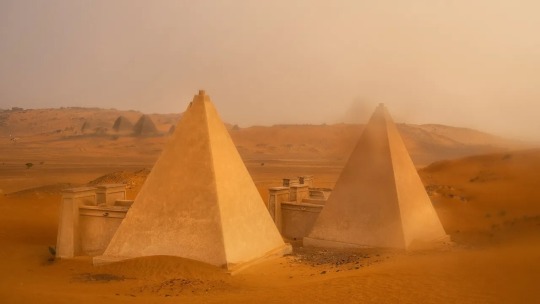
A “haboob” (sandstorm) rolls across the Meroë pyramids in Sudan. Most of the 41 tombs here belong to the royals of the powerful Kingdom of Kush (900 B.C. to A.D. 400), which ruled large parts of the middle Nile Valley.
Powered by agriculture, ancient Sudan’s great civilisations thrived and erected mighty temples and tombs honouring their gods, kings, queens, and nobles. Their building boom left behind some 255 pyramids—more than twice the number Egypt constructed next door.
Yet few Western travellers have seen these hulking sandstone relics. That’s because Sudan’s tourism industry has been impeded by two civil wars (1956-1972 and 1983-2005) and the battle for independence that led to the creation of South Sudan in 2011.
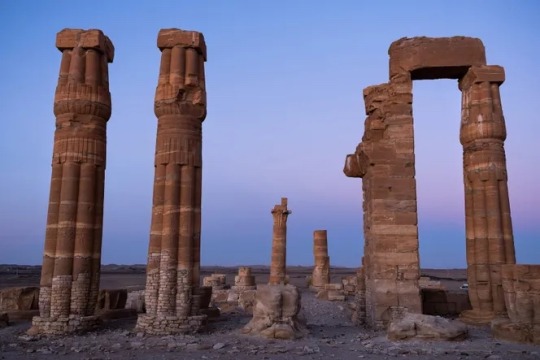
The temple of Soleb was built in the 14th century B.C. by Pharaoh Amenhotep III, in present-day Sudan. Visitors can still view its massive columns and splendid relief carvings.
Travel to Sudan is still currently not advised due to ongoing civil unrest related to a 2021 coup. However, when tensions ease, Sudan offers a singular chance to camp beside crowd-free ancient pyramids and to learn about the mysterious reign of these little-known pharaohs. A guided road trip along the Nile Valley takes you from the splendid temple at Soleb to the UNESCO-recognized Meroë, with the world’s largest cache of pyramids.
Black Pharaohs and a Once Great City
Nubia once stretched south from Aswan, Egypt, to modern-day Khartoum, Sudan. It gave rise to one of Africa’s earliest civilisations, the Kingdom of Kush, whose kings—nicknamed the Black Pharaohs—conquered Egypt in 747 B.C. and ruled the vast territory for nearly a century.
This drama played out on the banks of the world’s longest river, the Nile. Flowing south to north from Lake Victoria to the Mediterranean, the legendary waterway was considered the source of life itself because the annual flooding brought fertile soil for farming.
From the capital of Khartoum, it’s a nine-hour drive north to Soleb, Sudan’s best-preserved temple and the southernmost structure built by Amenhotep III, the Egyptian pharaoh who also commissioned the temples at Luxor. It was once guarded by the Prudhoe Lions, a pair of finely carved red granite beasts inscribed by the boy-king Tutankhamun when he visited. They are now displayed at London’s British Museum.
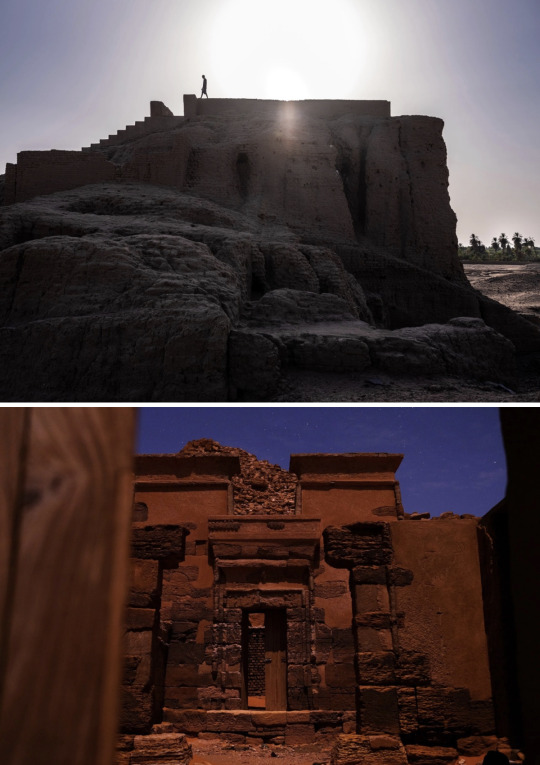
Top: Visitor Nadeem Abduraziq Mohammed walks through the ancient city of Kerma, Sudan, in July 2021. Kerma has been occupied for at least 8,000 to 10,000 years, reaching its peak around 1800 B.C., when it was capital of the Kingdom of Kush. Bottom: There are 41 tombs in Meroë’s north cemetery, 38 of them belonging to monarchs who ruled the region between B.C. 250 and A.D. 320.
Take a small barge from the village of Wawa to the western bank of the Nile, and you soon see the sandstone columns of Soleb’s main hall. Carved at their bases are images of Assyrians, hands chained behind their backs, whom the Black Pharaohs took as prisoners of war.
A few miles south of Soleb, set back from the tents where locals serve small glasses of tea beside the Nile, is Kerma. Established around 5,500 years ago, this ancient capital grew up around a huge adobe temple called the Western Defuffa. At its height the city had a population of 10,000; today, its mud brick ruins are inhabited only by nesting swallows. Nearby lies one of the oldest cemeteries in Africa.
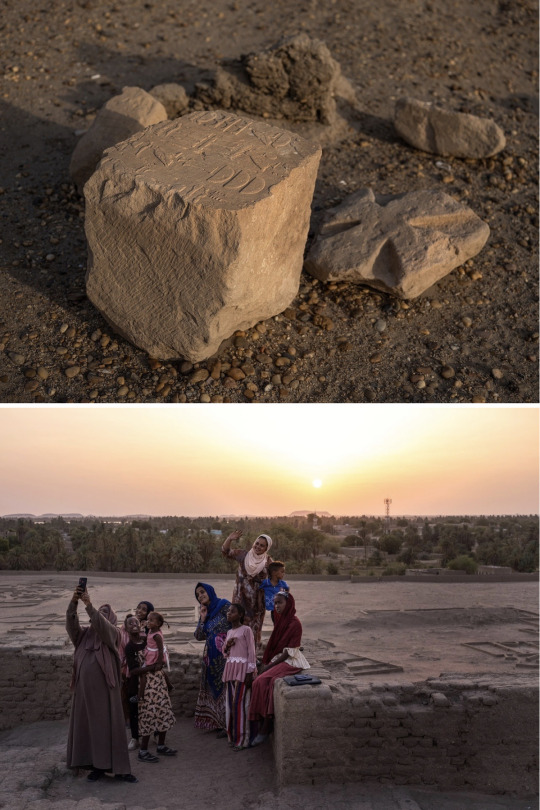
Top: A fragment of an ancient carving sits near the Kerma necropolis. This area of Sudan has been inhabited since Paleolithic times. Bottom: Tahani Abdulaziz takes a photograph of family members during a visit to Kerma.
Haunting Tombs and Dazzling Murals
Just over an hour’s drive south, and slowly being swallowed by sand, is Old Dongola. Founded with a fortress in A.D. 600, it served as the capital of the medieval Nubian kingdom of Makuria and grew to include palaces, houses, and Christian churches. It was a major stop on the Darb al-Arba’in (Forty Days Road) that thousands of camel caravans followed, transporting ivory and slaves between the Sudanese town of Darfur and Egypt.
Best preserved is the Church of the Old Granite Columns, its pale pillars framing a Throne Hall that was converted into a mosque in 1317 and remained in use until 1969. Now it’s open to visitors, along with an adjacent Islamic graveyard with distinctive 17th-century domed tombs known as qubbas.
From there, the Nile loops eastward and you come to El-Kurru, a cemetery used by the royal family of the Kingdom of Kush. Unlike in Egypt, Nubian burial chambers sit below the pyramids, not inside them.
Adobe tunnels cover the entrances to the chambers, chief among them the tomb of King Tanutamun (who died around 653 B.C.). Uneven shallow steps descend into the darkness until a flashlight click reveals a duo of domed rooms, one leading onto the other. Their white gypsum walls are covered with intricate murals in colours of ochre and yellow.
On the back wall is an arresting scene depicting Tanutamun’s heart being weighed against a feather by Maat, the goddess of truth. Kushites believed this recorded a person’s good and bad deeds and determined if the king’s soul could pass into paradise.

A Sudanese family tours El Kurru, a field of pyramids built for the kings and queens of ancient Kush.
More royal tombs crop up in Nuri, further upstream. Its smaller and steeper 70-plus pyramids are now reduced to 20. The most famous tombs belong to King Taharqa, the Black Pharoah who conquered Egypt, and King Nastasen, which archaeologists have to scuba-dive to reach because of rising ground waters.
Nuri served as the royal necropolis for the adjacent town of Napata, the first capital of the Kingdom of Kush. Both the cemetery and the ruins of the settlement lie across the Nile from Jebel Barkal, a 341-foot-tall sandstone mesa. From its summit, you can see the ruins of Nuri, including rows of cracked pillars and pairs of giant stone rams, their eyes and ears worn away by time.
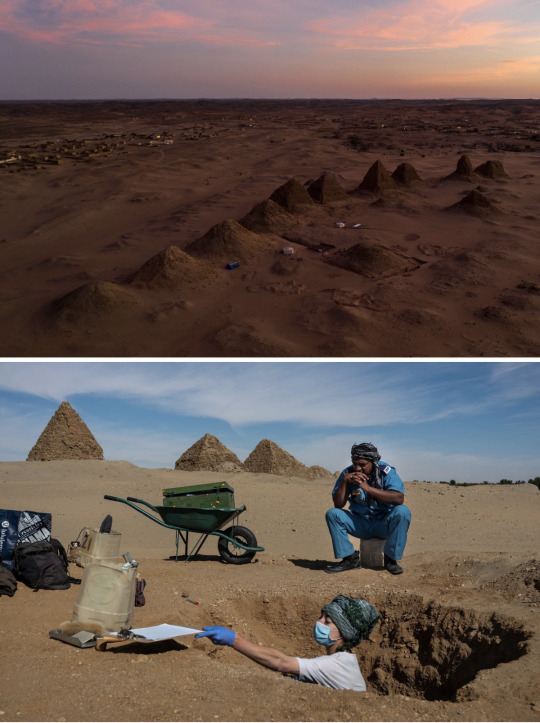
Top: The pyramids of Nuri, Sudan, were built between 650 and 300 B.C. The most famous tomb belongs to King Taharqa, the Black Pharaoh who conquered Egypt. Bottom: Archaeologist Gretchen Emma Zoeller excavates a burial site in Nuri. The ancient site sprawls across more than 170 acres along the Nile in northern Sudan.
On the western side of Jebel Barkal is a crumbling stone door frame leading to the Temple of Mut, wife of Amun. Spotlights illuminate its fine wall murals chronicling Taharqa’s coronation in white clay, ocher, and deep blue.
The World’s Largest Group of Pyramids
Finally, the Nile weaves past Meroë (pronounced Mero-way), the Kushite capital until the empire collapsed in A.D. 400 and site of Sudan’s best-preserved pyramids. More than 200 of them spread across the sands. Their granite and sandstone bases are etched with elephant, giraffe, and gazelle designs, proof that this was once fertile grasslands.
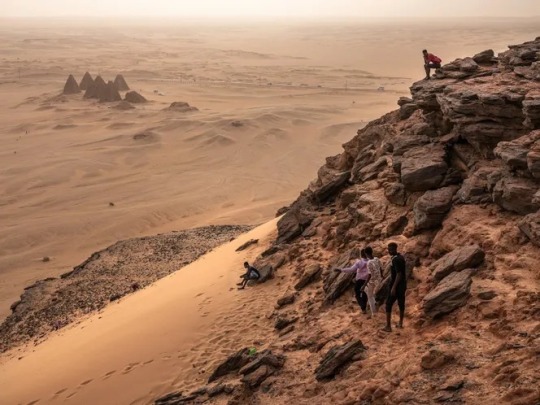
Sudanese tourists visit Jebel Barkal, Sudan, to climb the small butte, which has been considered sacred for thousands of years. Roughly a dozen pyramids are also scattered around the base of the mountain.
“It’s the biggest congregation of pyramids in the world,” reports archaeologist and Meroë site manager, Mahmoud Suliman. “At the time of the 2019 revolution, street signs, advertisements, and paintings all featured their images. It brought people together because the pyramids are so tied to our sense of identity.”
Mentioned in the writings of Herodotus, there’s an air of defiance about these structures that stand firm against the sands trying to swallow them. Indeed, it was an act of resistance that led to their construction in the first place. In the third century B.C., Kushite King Arakamani (Ergamenes) had grown tired of the Meroitic (Meroë-led) kingdom’s power-hungry high priests. So when they sent an order for him to commit suicide, he responded by having them all murdered instead.
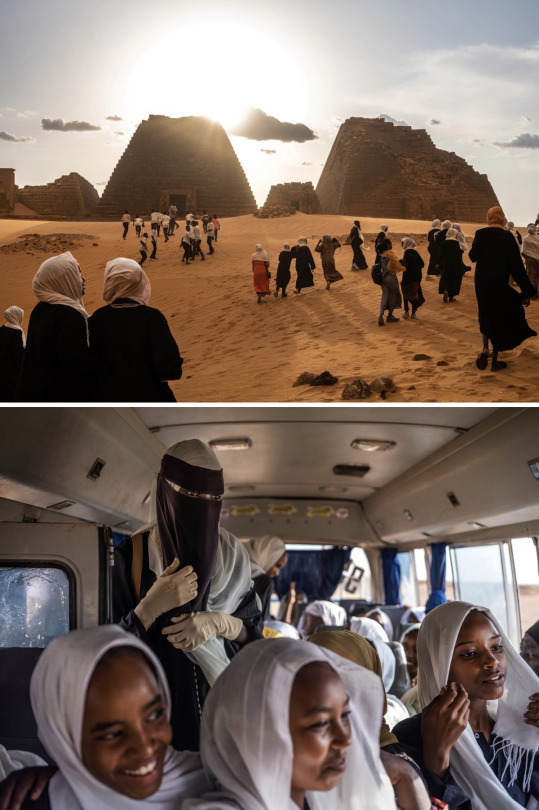
Top: A group of school children approach the pyramids at Meroë. Bottom: Volunteer tour guides show a group of Sudanese school children the Meröe pyramids. During the dictatorship of Omar al-Bashir from 1989 to 2019, Sudan’s school curriculum was infused with Islamic ideology and much of its rich ancient history was glossed over, but the new government wants to change that.
The rebellion ushered in a new era of culture: the almighty Egyptian god Amun-Ra was downgraded in favour of the lion god Abedemak, the (still undeciphered) Meroitic script was created, and warrior queens, known as kandakes, ruled the army. Inside the tombs, the carvings of the kings stand taller than the gods. You won’t see that in Egypt. Here, kings controlled everything except death.
It’s a strong message and one that’s inspired a fresh wave of national pride. For just as Ancient Greece informed so much of today’s European culture, so too did Nubia shape Sudan. It is the bedrock that formed the country’s sense of self and identity. Understanding this history suggests a way forward for Sudan.
“These were very popular kings and queens,” says Aya Allam, a Sudanese martial artist based in Khartoum. “They are a reminder that we were once a great nation and could become great once again.”
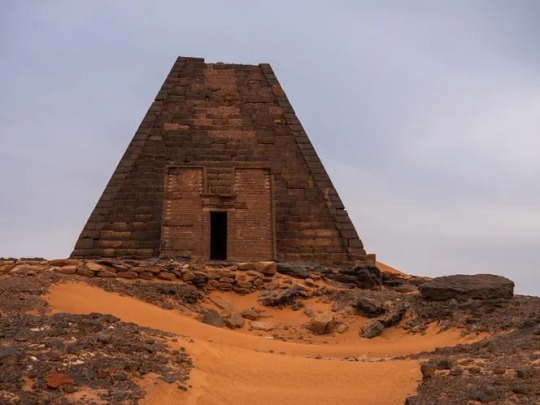
A pyramid covers a tomb in Meroë, Sudan. Rulers of the Kingdom of Kush were buried here underneath the steeply pitched structures, which range in height from 30 to one hundred feet tall, far shorter than the pyramids in nearby Egypt.
— Emma Thomson is a British Travel Writer. Nichole Sobecki is a Kenya-based Photographer.
#African Civilization#Mighty Pyramids#Mysterious Rulers#Sudan 🇸🇩#Tombs#Temples#Egypt 🇪🇬#Cairo#Emma Thompson#Nichole Sobecki#Black Pharaohs#Haunting Tombs | Dazzling Murals
3 notes
·
View notes
Text
16.04. READING WEEK 13.
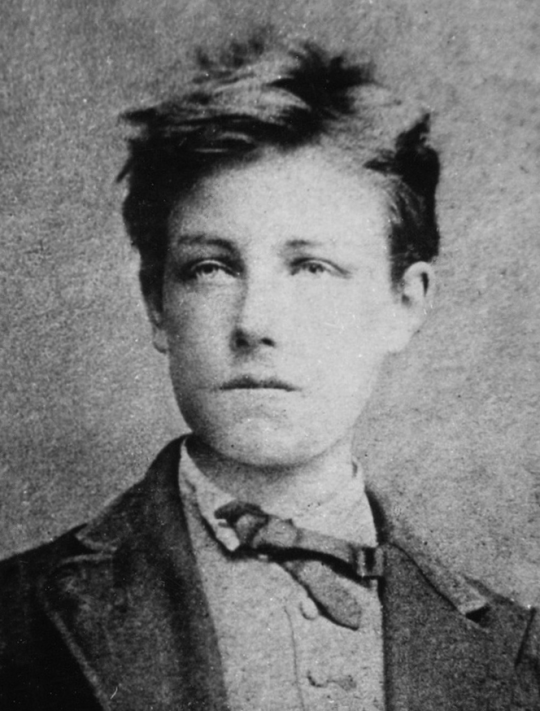
ON MAY 15, 1870, ARTHUR RIMBAUD WRITES:
on the calm black water where the starts are sleeping
white Ophelia floats like a great lily;
floats very slowly, lying in her long veils…
in the far-off woods you can hear them sound the mort.
for more than a thousand years sad Ophelia
has passed, a white phantom, down the long black river.
for more than a thousand years her sweet madness
has murmured its ballad to the evening breeze.
the wind kisses her breasts and unfolds in a wreath
her great veils rising and falling with waters;
the shivering willows weep on her shoulder,
the rushes lean over her wide, dreaming brow.
[…]
o pale Ophelia! beautiful as snow!
yes child, you died, carried off by a river!
it was the winds descending from the great mountains of Norway
that spoke to you in low voices of better freedom.
[…]
it was the voice of mad seas, the great roar,
that shattered your child’s heart, too human and too soft;
it was a handsome pale knight, a poor madman
who one April morning sate mute at your knees!
IN A PARALLEL BETWEEN RIMBAUD’S POEM “OPHELIA”, AND THE IMAGE OF THE CORPSE OF ALAN KURDI DESCRIBED IN EMILY REGAN WILLS’S “ALAN KURDI’S BODY ON THE SHORE”, ALAN KURDI IS OPHELIA.
THE WIND UNFOLDS IN A WREATH HIS KID-SIZE JEANS AND SHOES; IT MAKES THEM RISE AND FALL WITH THE WATERS.
THOSE WINDS, DESCENDING FROM THE SOULS OF THE HALICARNASSUS’ MAUSOLEUM, NEAR THE TURKISH BODRUM BEACH WHERE HE WAS FOUND, SPOKE TO HIM IN VOICES OF BETTER FREEDOM.
YET, IT WAS THE LONG BLACK MEDITERRANEAN RIVER’S VOICE THAT SHATTERED HIS CHILD’S HEART.
FROM HIS BANKS, THE WESTERN WOODS ARE NOT THAT FAR-OFF.
THERE, FOR MORE THAN A THOUSAND YEARS, WE HEAR THE MORT, IN THE FORM OF A PHOTOGRAPH, CAPTURED BY A POOR MADMAN, ON ONE SEPTEMBER MORNING.
BOTH EMILY REGAN WILLS AND ENRICO DE ANGELIS’S ARTICLES TOUCH ON THE IMPLICATIONS OF SHOWING IMAGES PORTRAYING DEAD PEOPLE, ESPECIALLY IN THE CONTEXT OF WARS LIKE THE SYRIA’S ONE.
THE ANALYSIS REVOLVES AROUND THE ISSUE OF BRUTAL IMAGES ACTING EITHER AS RELICS FOR THE EVENTS THEY DEPICT OR, IN OTHER CASES, AS OFFENSIVE REPRESENTATIONS.
EMILY REGAN WILLS ANALYSES, FOR INSTANCE, THE IMAGE OF ALAN KURDI'S CORPSE AS IT BEING BOTH A DISTURBING QUIET IMAGE OF 3-YEAR-OLD DEAD CHILDREN, AND WHAT THE WESTERN COUNTRIES NEED TO TAKE ACTION, FIGURATIVELY, IN STANCE OF IMMIGRATION.
SMALL DONATIONS AND HUGE PROMISES, AND YET WE FACE THE REALITY: EUROPE STILL DOES NOT HAVE A FAIR AND RESPECTED TREATY OVER IMMIGRATION.
THIS IS THE POLITICS OF THE NOW, IN WHICH DREADFUL PICTURES ARE USED TO SAVE OUR FACES INSIDE AN UNFINISHED ELECTORAL CAMPAIGN.
DAY BY DAY, CONTEMPORARY LIVE NEWS CHANNELS ARE REMINISCENT OF THE DE ANGELIS AL KATHIB’S SYRIAN ARCHIVE: A COMPENDIUM OF TRAGEDIES OPENLY STREAMED 24 HOURS A DAY.
VIRUSES PREVENTIONS. NATURAL CATASTROPHISE. DROWNINGS. CLIMATE CHANGE.
ON TALK SHOWS WE REDUCE THESE INSTANCES AMONG “COMPLEX ARGUMENTS”; SMALL DISQUISITIONS ARE SUFFICIENT TO PASS ON TO THE NEXT ARGUMENT.
RELENTLESSLY, WE STRIVE FOR THAT ACCIDENT, THAT IMAGE, WHICH SHOCKS OUR WESTERN TEA DRINKERS’ CONSCIENCES.
IN THIS CONTEXT, IT MAKES YET MORE SENSE TO PARALLEL ALAN KURDI’S IMAGE WITH THE 1852 PAINTING OF OPHELIA BY PRE-RAPHAELITE ARTIST JOHN EVERETT MILLAIS.

1852 JOHN EVERETT MILLAIS' OPHELIA IN COMPARISON WITH 2015 IMAGE OF THE CORPSE OF ALAN KURDI
IN THE SHAKESPEARIAN’S HAMLET OPHELIA, FILLE MAUDITE, IS A VICTIM OF THE EVENTS HAPPENING AROUND HER, OVER WHICH SHE DOES NOT HAVE CONTROL, MOSTLY SINCE THEY ARE ARRANGED BY POWERFUL MEN FIGURES.
SUICIDAL BY DROWNING, HER DEATH IS NOT SHOWN DIRECTLY, BUT NARRATED THROUGH ANOTHER FEMALE FIGURE, GERTRUDE.
AS IF, HER DEATH’S ABSENCE ON STAGE WOULD ACT FOR THE PRESENCE OF SUCH DRAMA.
A DRAMA WHICH, IN OUR CONTEMPORARY TIMES, MUST BE AMPLIFIED ON THE SOCIAL MEDIA STAGE, IN ORDER TO BE PROCESSED.
IT CAN HAVE ITS 15 MINUTES OF FAME, ACTING DAZZLING, AS OPHELIA’S WANDERING RAVINGLY AMONG THE WOODS.
THE LAST MINUTES BEFORE CEASING TO EXIST, GOING BACK TO BEING ABSENTLY PRESENT.
GENTLY OPHELIA, LYING DEAD AMONG THOSE SURREY’S WOODS CRITICIZED BY ART CRITIC JOHN RUSKIN, WHO WILL THEN REQUIRE THEM FOR HIS OWN PORTRAIT.
HEROICAL OPHELIA, PERSONIFIED BY ELIZABETH SIDDAL INSIDE A VICTORIAN HOT BATH. PLACED THERE BY HIS HUSBAND DANTE GABRIEL ROSSETTI AND FRIEND JOHN MILLAIS, SHE WILL END UP GETTING A FEVER FOR ART.
ART FOR ART’ SAKE.
ART FOR DEATH ‘SAKE: STILL, WE ARE RESEARCHING THE PERFECT, INSTANTANEOUS WESTERN SHOT PORTRAYING DEATH.
INHERENTLY WAITING, FOR THE FINAL HARD RAIN THAT WILL GONNA FALL.
youtube
PERFORMING "A HARD RAIN'S A GONNA FALL", BOB DYLAN SINGS ABOUT "SOME SORT OF END THAT'S JUST GONNA HAPPEN".
0 notes
Text
MakeIT Haverhill Job Fair Thursday Adds Bank, Nonprofits Posts to Employment Availability
MakeIT Haverhill Job Fair Thursday Adds Bank, Nonprofits Posts to Employment Availability
To submit Business Bulletin announcements, click on image.
Positions at a bank and two nonprofits join the availability of manufacturing, warehouse, driving and other jobs showcased at the latest MakeIT Haverhill job fair this Thursday afternoon.
Employers include Bank of New England, Community Action, Opportunity Works, Beacon Mobility and NRT Bus, Bradford Industries, Cedar’s Mediterranean…
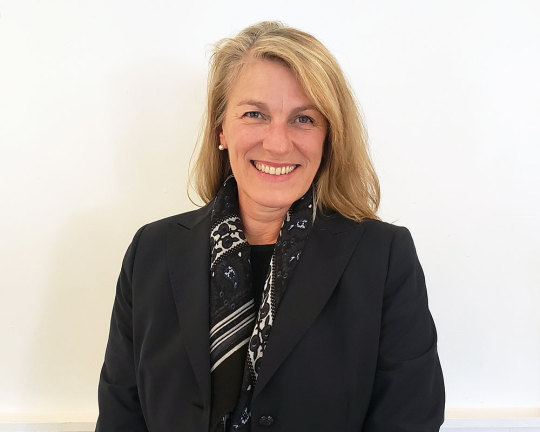
View On WordPress
0 notes
Text
Everything You Need To Know About The World's Longest Rivers
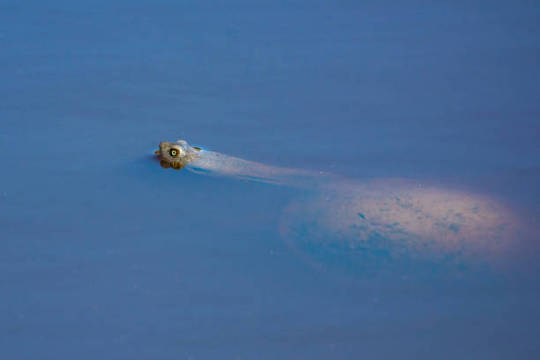
Amazon and Nile are the longest rivers around the globe, and the Amazon is the largest in water volume of any river on earth. The Amazon is responsible for one fifth of freshwater that enters the oceans. Read on to learn more about these incredible waters.
Yangtze River
The Yangtze River runs through China and covers an area of 3.7 million square miles. Its drainage area provides water and food for the approximately 400 million inhabitants. The longest rivers in the world is also a major transportation artery connecting China's interior with the coastline. Its flow is one of the biggest in the world , and it transports a wide range of products, including coal, manufactured products, and passengers. The river carried 795 million tonnes of cargo in 2005.
The Yangtze River rises in the Tanggula Mountains and flows 3,900 miles to the East China Sea. The image was taken by the Copernicus Sentinel-2 satellite near the city of Chongqing. This image illustrates how the levels of water are declining due to rising temperatures. Rivers are losing water and sediments that are rising to sea levels. This can be seen in western portion of the river.
Amazon River
The Amazon River, a glacial river, is a part of Peru's Andes. It measures six and a quarter thousand miles long, which makes it the longest rivers in the world. The origins of the river aren't entirely clear. Scientists think that the Amazon's glacial river is the consequence of Nevado Mismi (a mountain in Peruvian Andes).
The length of the Amazon River is the result of several tributaries, including the Para River and the Northern Amazon River Channel. The two channels, also known as"furo, "furo," connect the Amazon to the Atlantic Ocean. This allows you to visit the Amazon's mouth and is geographically bizarre.
Nile River
The Nile River flows 6,600 km and empties into Mediterranean Sea. The Nile longest river has served as a major source of irrigation and transportation for thousands upon many thousands of years. It remains an important waterway. Families still gather water from the river's banks, and you can see the ancient Egyptian ruins along its banks.
Three main streams form the Nile River. The Blue Nile rises in Ethiopia The Atbara comes from the mountains of Ethiopia, and the White Nile starts in Lake Victoria.
Summary:
These photos offer a unique view of the changes that rivers face due to changes in the climate. Each photo tells a tale of how river health can be affected through changes in water levels and sedimentation or temperatures. Copernicus Sentinel-2 satellite missions provides important information on the global climate shift. This can aid in understanding why our world is changing.
0 notes
Text
On this day in Wikipedia: Wednesday, 21st February
Welcome, merħba, ողջու՜յն (voġčuyn), მოგესალმებით (mogesalmebit) 🤗
What does @Wikipedia say about 21st February through the years 🏛️📜🗓️?

21st February 2022 🗓️ : Event - Prelude to the Russian invasion of Ukraine
In the Russo-Ukrainian crisis Russian President Vladimir Putin declares the Luhansk People's Republic and Donetsk People's Republic as independent from Ukraine, and moves troops into the region. The action is condemned by the United Nations.
"In March and April 2021, prior to the 2022 Russian invasion of Ukraine, the Russian Armed Forces began massing thousands of personnel and military equipment near Russia's border with Ukraine and in Crimea, representing the largest mobilisation since the illegal annexation of Crimea in 2014. This..."
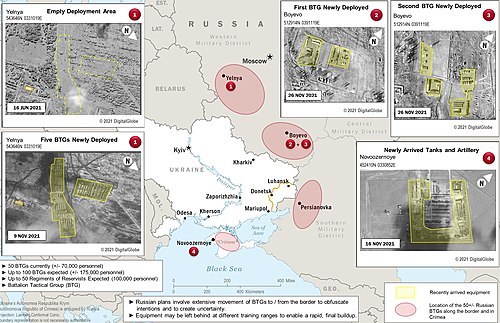
Image by U.S. intelligence agencies (unclassified)
21st February 2019 🗓️ : Death - Stanley Donen
Stanley Donen, American film director (b. 1924)
"Stanley Donen ( DON-ən; April 13, 1924 – February 21, 2019) was an American film director and choreographer. Donen directed some of the most iconic films of the Golden Age of Cinema. He received the Honorary Academy Award in 1998, and the Career Golden Lion at the Venice Film Festival in 2004. Four..."

Image licensed under CC BY-SA 3.0? by Adam Schartoff
21st February 2014 🗓️ : Death - Héctor Maestri
Héctor Maestri, Cuban-American baseball player (b. 1935)
"Héctor Anibal Maestri Garcia (April 19, 1935 – February 21, 2014) was a Cuban-born Major League Baseball pitcher. Maestri was one of nine ballplayers to have appeared for both of the 20th century, American League Washington Senators franchises, and one of only three to have played for them in..."
21st February 1974 🗓️ : Event - Suez Canal
The last Israeli soldiers leave the west bank of the Suez Canal pursuant to a truce with Egypt.
"The Suez Canal (Egyptian Arabic: قَنَاةُ ٱلسُّوَيْسِ, Qanāt es-Suwais) is an artificial sea-level waterway in Egypt, connecting the Mediterranean Sea to the Red Sea through the Isthmus of Suez and dividing Africa and Asia (and by extension, the Sinai Peninsula from the rest of Egypt). The..."

Image licensed under CC BY-SA 2.5? by Baycrest
21st February 1924 🗓️ : Birth - Thelma Estrin
Thelma Estrin, American computer scientist and engineer (d. 2014)
"Thelma Estrin (née Austern; February 21, 1924 – February 15, 2014) was an American computer scientist and engineer who did pioneering work in the fields of expert systems and biomedical engineering. Estrin was one of the first to apply computer technology to healthcare and medical research. In 1954,..."
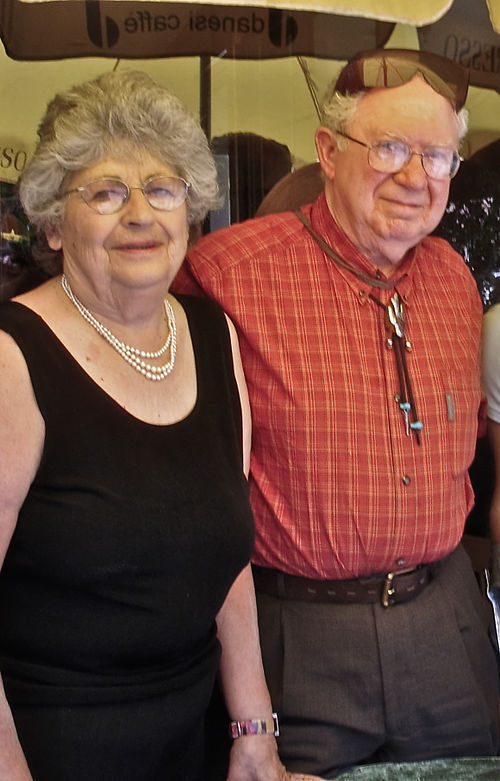
Image licensed under CC BY-SA 3.0? by Achituv (talk)
21st February 1824 🗓️ : Death - Eugène de Beauharnais
Eugène de Beauharnais, French general (b. 1781)
"Eugène Rose de Beauharnais ([øʒɛn də boaʁnɛ]; 3 September 1781 – 21 February 1824) was a French nobleman, statesman, and military commander who served during the French Revolutionary Wars and the Napoleonic Wars. Through the second marriage of his mother, Joséphine de Beauharnais, he was the stepson..."
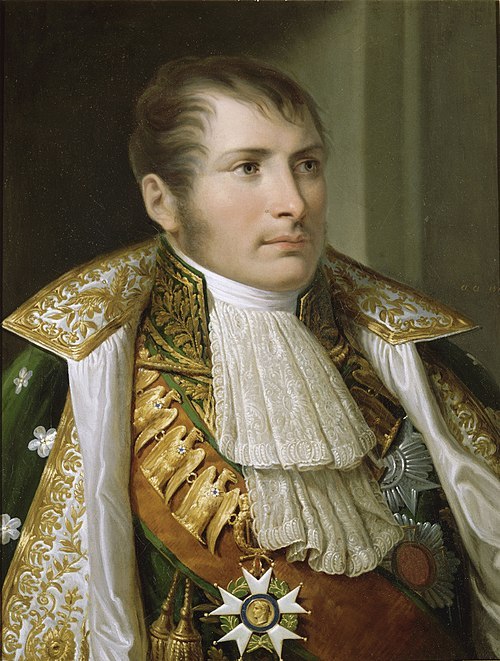
Image by Andrea Appiani
21st February 🗓️ : Holiday - Birthday of King Harald V (Norway)
"Harald V (Norwegian: Harald den femte, Norwegian pronunciation: [ˈhɑ̂rːɑɫ dɛn ˈfɛ̂mtə]; born 21 February 1937) is King of Norway. He succeeded to the throne on 17 January 1991. Harald was the third child and only son of King Olav V of Norway and Princess Märtha of Sweden. He was second in the line..."
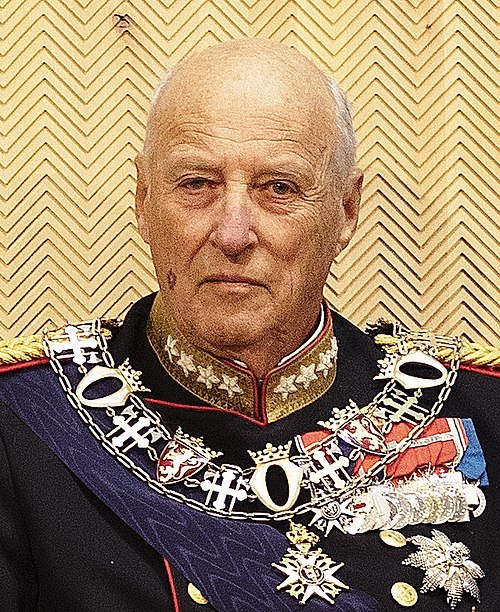
Image licensed under CC BY 2.0? by Sámediggi - Sametinget
0 notes